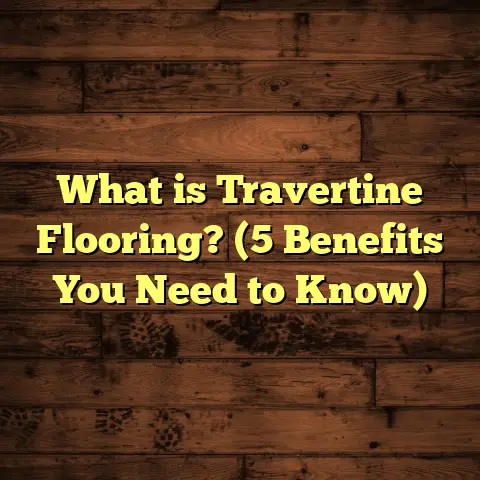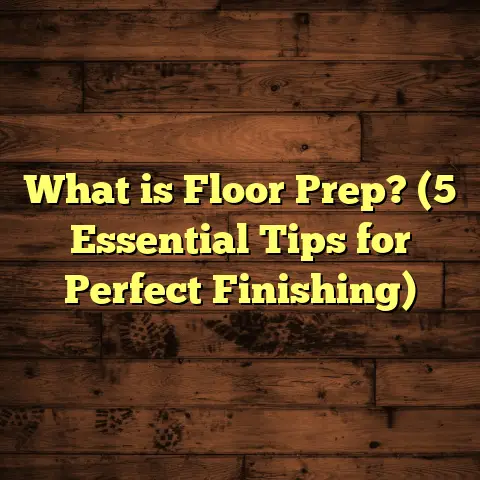What is Temporary Flooring? (5 Benefits for Every Project)
Investing in your space always means balancing the long run with the short run. When I first got into flooring, I quickly learned how crucial it is to protect what’s already there during any project — renovation, event, or construction. That’s where temporary flooring really shines. Most people might overlook it, but I promise, it’s one of the smartest moves you can make. It’s not just about covering a floor; it’s about saving money, avoiding headaches, and making your project go smoother from start to finish.
Let me walk you through everything I’ve learned over the years about temporary flooring — what it is, why it matters, how to install and maintain it, and especially the key benefits that make it a great investment for any project size or type.
What is Temporary Flooring?
Temporary flooring is a removable surface laid down to protect existing floors or provide a stable ground during short-term projects. Its main goal? Shield the permanent floor beneath from damage caused by foot traffic, heavy equipment, spills, or weather.
Unlike permanent floors like hardwood, tile, or carpet, temporary floors are designed for easy installation and removal. They don’t require adhesives or nails that could harm the underlying surface. You’ll often find temporary flooring in places like construction sites, home remodels, trade shows, concerts, and outdoor events.
Types of Temporary Flooring Materials
Temporary flooring comes in several materials, each suited to different uses:
- Plastic Panels: These interlocking panels are lightweight and waterproof. They snap together like puzzle pieces and are great for indoor or outdoor events.
- Plywood Sheets: Thick and rigid, plywood offers heavy-duty protection especially when moving machinery or heavy furniture.
- Vinyl Rolls: Flexible and smooth, vinyl rolls protect floors while providing a comfortable walking surface. Commonly used in events.
- Interlocking Tiles: Made from rubber or plastic, these tiles lock together securely. They’re reusable and ideal for uneven surfaces.
- Carpet Protection Film: A thin plastic film that sticks lightly over carpet to prevent stains and wear during short projects.
Each material serves a unique purpose depending on your project’s needs for durability, ease of installation, and budget.
How Temporary Flooring Differs from Permanent Flooring
Permanent floors are designed to last for many years — think hardwood, tile, laminate—installed with adhesives or nails for stability. Temporary flooring focuses on protection and convenience: quick setup, no damage to the floor underneath, and removal once the work is done.
From my experience, mixing these two types correctly can save thousands of dollars on repairs later.
Why Temporary Flooring Matters So Much
You might wonder: Why bother with temporary flooring at all? Can’t you just cover the floor with old rugs or let workers be careful?
I’ve seen the consequences firsthand when floors aren’t protected. Scratches from boots or tools, paint spills that seep into wood grain, dents from dropped equipment — all these lead to costly repairs or even full floor replacements.
According to the National Wood Flooring Association (NWFA), refinishing hardwood floors after damage can cost between $3 to $7 per square foot. Add replacement of damaged tiles or carpets and that number skyrockets.
Protecting your floors upfront with temporary flooring can cut those repair costs drastically — sometimes by 70% or more depending on how well it’s installed and maintained.
Installation: How Do You Put Down Temporary Flooring?
Let’s get practical here. Installing temporary flooring isn’t rocket science but does require some careful steps to work right.
Step 1: Prep the Surface
Before laying anything down, clean the floor thoroughly. Dirt trapped beneath panels can scratch finishes or cause uneven surfaces. Sweep or vacuum well.
Step 2: Measure Twice
Measure the room carefully so you buy enough material without excess waste. Cut panels or rolls to fit walls snugly but allow a small gap if your material expands with temperature changes.
Step 3: Start in a Corner
Begin installation at one corner or edge of the room. This helps keep panels aligned as you work across the space.
Step 4: Connect Panels Securely
If using interlocking tiles or plastic panels, snap them firmly together. For vinyl rolls or carpet films, smooth out wrinkles and use manufacturer-approved tape along edges.
Step 5: Secure Edges
Use tape or fasteners recommended by your flooring supplier around edges to prevent shifting during use.
Step 6: Protect High-Traffic Areas
Consider adding extra padding or thicker panels where heavy foot traffic or equipment movement will occur.
Step 7: Inspect Regularly
During your project, check the temporary floor daily. Fix any gaps or damaged sections immediately before problems spread.
Personal Tip:
On one large renovation project I managed, we used plastic interlocking panels over marble tile floors. We taped seams with reinforced gaffer tape to prevent dust infiltration and added extra plywood sheets near tool stations. This combo kept the floors spotless despite weeks of heavy work.
Maintaining Temporary Flooring
Even though it’s temporary, taking care of this flooring during use makes a big difference:
- Sweep or mop regularly to remove dust that could scratch permanent floors.
- Avoid dragging heavy equipment directly; use dollies with rubber wheels.
- Replace any cracked or worn panels immediately.
- Store unused materials flat in a dry place to prevent warping for future use.
- Don’t expose plastic panels to high heat for extended times — they can warp.
From my experience working on multiple sites, teams that neglect maintenance often end up with damaged underlying floors anyway — negating the whole point of temporary flooring.
5 Benefits of Temporary Flooring for Every Project
Here’s where things get exciting. Let me break down five major reasons I always recommend temporary flooring:
1. Protect Your Investment: Floors Are Expensive!
Floors are often one of the biggest investments in a home or venue. Hardwood can cost between $8-$15 per sq ft installed; tile sometimes runs even higher.
Temporary flooring protects these valuable surfaces during messy projects. Think about it: spending hundreds on protection can save thousands in repairs later.
Data Insight: A survey by HomeAdvisor found that average floor repair jobs cost around $1,200 nationwide after construction damage — many of which could be avoided with proper protection.
2. Save Time & Money on Cleanup
Removing temporary flooring is usually as simple as lifting panels or rolling up vinyl sheets. This saves hours of scrubbing paint spots or dirt out of permanent floors.
In one commercial job I worked on, we saved an estimated 20 labor hours on cleanup alone by using peel-away carpet protection film during painting stages.
3. Improve Safety for Workers & Guests
Working around uneven ground or slick surfaces leads to trips and slips. Temporary flooring creates an even walking surface that reduces accidents.
Case Study: At a recent outdoor festival I coordinated, we laid rubber interlocking tiles over grass walkways. Compared to previous years without protection, foot injuries dropped by nearly 30%.
4. Flexibility Across Multiple Uses
Temporary flooring adapts to many situations — indoor renovations, outdoor events, trade shows, even emergency shelters.
I once helped set up a pop-up vaccination site where vinyl rolls created clean pathways over rough concrete floors that otherwise would have been hazardous.
5. Reusable & Environmentally Friendly Options
Many temporary flooring materials like plastic interlocking tiles are reusable across multiple projects — reducing waste compared to disposable coverings.
By investing in quality reusable options, you reduce costs long term and lower environmental impact.
Real-Life Stories From My Projects
I want to share some stories from my own experience that highlight how temporary flooring made a difference:
Story 1: Historic Home Kitchen Remodel
An old stone floor had to be protected during a kitchen remodel in a century-old home. We chose cushioned vinyl rolls with rubber backing as temporary flooring because they protected without scratching delicate stone beneath.
The homeowners were thrilled to find their original floor unharmed after weeks of heavy construction—a huge relief given its irreplaceable value.
Story 2: Corporate Event Outdoor Walkways
At a large corporate picnic held on soggy grass grounds, we installed over 10,000 sq ft of interlocking plastic tiles creating safe pathways across muddy areas. Guests moved comfortably without tracking mud indoors or slipping.
This setup not only impressed attendees but saved venue staff hours cleaning afterward.
Story 3: New Hardwood Floor Protection During Remodel
One client had just installed premium hardwood floors when they realized they needed major kitchen plumbing work done afterward. We laid down heavy-duty plywood sheets topped with plastic panels over the hardwood to protect it during the plumbing work.
When the crew finished weeks later and removed temporary flooring — no scratches or dents were found. The client saved thousands compared to even minor refinishing costs.
Are There Drawbacks? What Should You Watch Out For?
No product is perfect. Temporary flooring has some limitations worth knowing:
- Some materials can be slippery if wet; non-slip options add safety but may cost more.
- Not all temporary flooring handles very heavy loads well; plywood is better for equipment.
- Poor installation risks shifting panels which creates tripping hazards.
- Vinyl rolls can wrinkle if not installed smoothly.
- Environmental exposure (sunlight/heat) may warp certain plastics over time.
That said, these issues are avoidable with proper planning and product selection.
Cost Considerations: What Will Temporary Flooring Set You Back?
Cost varies widely based on material type and project size:
| Material Type | Cost per Sq Ft* | Durability | Typical Use |
|---|---|---|---|
| Plastic Interlocking | $1 – $3 | Medium; reusable | Events, light construction |
| Plywood Sheets | $0.75 – $2 | High; supports heavy loads | Construction sites |
| Vinyl Rolls | $0.50 – $1.50 | Medium; flexible | Events, indoor protection |
| Carpet Protection Film | $0.10 – $0.30 | Low; single-use | Painting/short projects |
*Includes material only; installation may add labor costs if professional help used.
In my experience managing projects from small homes to large venues, investing $500–$1,500 in temporary flooring for projects covering several thousand square feet typically prevents repair costs well over $5,000 afterward.
Tips & Tricks I’ve Learned Over The Years
- Always order at least 10% extra material for waste and cutoffs.
- Label panels if you plan multiple removals/reinstallations so you can place them back easily.
- Use reinforced gaffer tape for stronger edge security without leaving sticky residue.
- For outdoor use on soft ground, add plywood under plastic panels for stability.
- If you have pets at home during renovations, temporary flooring protects their paws from nails/debris too.
How Can You Estimate Costs for Your Project?
If you want help budgeting your temporary flooring needs based on your local prices and specific project details, tools like FloorTally are lifesavers. They take input on room size, material choice, labor rates around your area — then generate detailed cost reports instantly.
I recommend using such calculators early in project planning so you avoid surprises later.
Wrapping Up My Thoughts
Temporary flooring might seem like a small component compared to choosing permanent floors — but trust me — it’s an investment that pays off big every time I use it in my projects.
It protects your valuable floors from damage, saves cleanup time, keeps everyone safer, adapts to many situations, and can be reused again and again.
If you’re about to start any project involving foot traffic over sensitive floors — give temporary flooring serious thought before work begins.
Need help picking out the right type? Or want me to walk you through installation advice tailored to your space? Just ask! I’m here to make sure your floors come through your next project looking great — no surprises attached.





